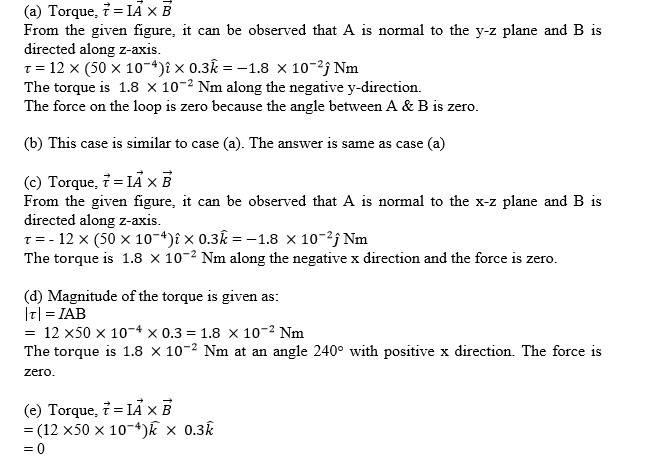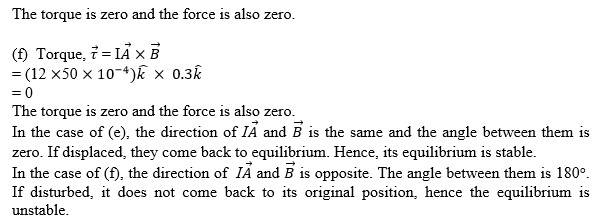Torque on current loop, magnetic loop dipole: In electromagnetic theory, understanding the concept of torque on a current loop, magnetic dipole, and magnetic dipole moment is important for Class 12 NCERT Physics students. On this page, all the numerical problems included in this topic are answered.
Magnetic Dipole
Current Loop: A current loop is simply a closed path along which electric charges are flowing. It can be a simple closed circuit, like a circular wire, or a more complex shape with current flowing through it. When electric charges move through this loop, they create a magnetic field in the surrounding space.
Magnetic Dipole: A magnetic dipole is a fundamental concept in electromagnetism. It consists of two equal and opposite magnetic poles (North and South poles) separated by a small distance. This system can be considered as a tiny bar magnet or a loop of current in which the current circulates in a closed path.
Torque on a Current Loop
When a current-carrying loop is placed in a magnetic field, it experiences a torque, which is a rotational force. The magnitude of this torque (τ) on the current loop is given by the equation:
τ = μBsin(θ)
Where:
τ is the torque.
μ (mu) is the magnetic moment of the loop, which is the product of the current (I) flowing through the loop and the area (A) of the loop perpendicular to the current: μ = IA.
B is the magnetic field strength.
θ is the angle between the magnetic moment vector (μ) and the magnetic field vector (B).
The direction of the torque is perpendicular to the plane of the loop and follows the right-hand rule, meaning that the direction of the torque vector can be determined by curling the fingers of your right hand in the direction of the current flow and then pointing your thumb in the direction of the magnetic field.
Applications of Torque on a current loop
Torque on a current loop is a fundamental principle used in various electrical and electronic devices, such as electric motors and generators. It helps in understanding how these devices convert electrical energy into mechanical energy and vice versa.
In summary, the torque on a current loop in a magnetic field is a key concept in electromagnetism, and it plays a crucial role in understanding the behavior of magnetic dipoles and their interaction with external magnetic fields.
FAQs on Torque on current loop, magnetic loop dipole
Q. (a) A circular coil of 30 turns and radius 8.0 cm carrying a current of 6.0 A is suspended vertically in a uniform horizontal magnetic field of magnitude 1.0 T. The field lines make an angle of 60° with the normal of the coil. Calculate the magnitude of the counter torque that must be applied to prevent the coil from turning. (b) Would your answer change, if the circular coil in (a) were replaced by a planar coil of some irregular shape that encloses the same area? (All other particulars are also unaltered.)
Number of turns of the circular coil, n = 30
Radius of the coil, r = 8.0 cm = 0.08 m
Area of the coil, A = = = 0.0201
Current flowing in the coil, I = 6.0 A
Magnetic field strength, B = 1 T
Angle between the field line and normal of the coil surface, = 60
The coil experiences a toque in the magnetic field, hence it turns.
The counter torque is given by the relation,
= 30 = 3.133 N
- Since the magnitude of the torque is not dependent on the shape of the coil, it depends only on the area. Hence he answer will not change if the circular coil is replaced with a planar coil of same area.
Q. For a circular coil of radius R and N turns carrying current I, the magnitude of the magnetic field at a point on its axis at a distance x from its centre is given by, B = (μ_0 IR^2 N)/(2(〖x^2+ R^2)〗^(3/2) ) (a) Show that this reduces to the familiar result for field at the centre of the coil. (b) Consider two parallel co-axial circular coils of equal radius R, and number of turns N, carrying equal currents in the same direction, and separated by a distance R. Show that the field on the axis around the mid-point between the coils is uniform over a distance that is small as compared to R, and is given by, B =0.72(μ_0 NI)/R , approximately. [Such an arrangement to produce a nearly uniform magnetic field over a small region is known as Helmholtz coils.]
Radius of the circular coil = R
Number of turns on the coil = N
Current in the coil= I
Magnetic field at a point on its axis at a distance x is given as:
B =
where = Permeability of free space = 4 T m
- If the magnetic field at the centre of the coil is considered, then x = 0, then
B = =
This is the familiar result for magnetic field at the centre of the coil.
- Radius of two parallel co-axial circular coils = R
Number of turns on each coil = N
Current in both the coils = I
Distance between both the coils = R
Let us consider point Q at a distance d from the centre.
Then one coil is at a distance of + d from point Q
Magnetic field at point Q is given as:
=
, the other coil is at a distance of – d from point Q,
Magnetic field due to this coil is given as
=
Total magnetic field, B = +
= +
=
=
=
For d, neglecting the factor , we get
=
=
=
B = 0.72
Hence, it is proved that the field on the axis around mid-point between the coils is uniform.
Q. A uniform magnetic field of 3000 G is established along the positive z-direction. A rectangular loop of sides 10 cm and 5 cm carries a current of 12 A. What is the torque on the loop in the different cases shown in Fig. 4.28? What is the force on each case? Which case corresponds to stable equilibrium?
Magnetic field strength, B = 3000G = 3000 T = 0.3 T
Length of the rectangular loop, l = 10 cm
Width of the rectangular loop, b = 5 cm
Area of the loop, A = l = 10 = 50 = 50
Current in the loop, I = 12 A
Assume that the anti-clockwise direction of the current is positive and vice versa.


Q. A circular coil of 20 turns and radius 10 cm is placed in a uniform magnetic field of 0.10 T normal to the plane of the coil. If the current in the coil is 5.0 A, what is the (a) total torque on the coil, (b) total force on the coil, (c) average force on each electron in the coil due to the magnetic field? (The coil is made of copper wire of cross-sectional area 10–5 m2, and the free electron density in copper is given to be about 1029 m–3.)
Number of turns on the circular coil, n =20
Radius of the coil, r = 10 cm = 0.1 m
Magnetic field strength, B = 0.10 T
Current in the coil, I = 5.0 A
- The total torque on the coil is zero because the field is uniform.
- The total torque on the coil is zero because the field is uniform.
- Cross-sectional area of the copper coil, A =
Number of free electrons per cubic meter of copper, N = /
Charge on the electron, e = 1.6 C
Magnetic force, F = Be where is the drift velocity of electrons
= = = 5 N
The average force on each electron is 5 N
News & Updates
Physics Electromagnetic Induction Exam
Student Forum
Popular Courses After 12th
Exams: BHU UET | KUK Entrance Exam | JMI Entrance Exam
Bachelor of Design in Animation (BDes)
Exams: UCEED | NIFT Entrance Exam | NID Entrance Exam
BA LLB (Bachelor of Arts + Bachelor of Laws)
Exams: CLAT | AILET | LSAT India
Bachelor of Journalism & Mass Communication (BJMC)
Exams: LUACMAT | SRMHCAT | GD Goenka Test
